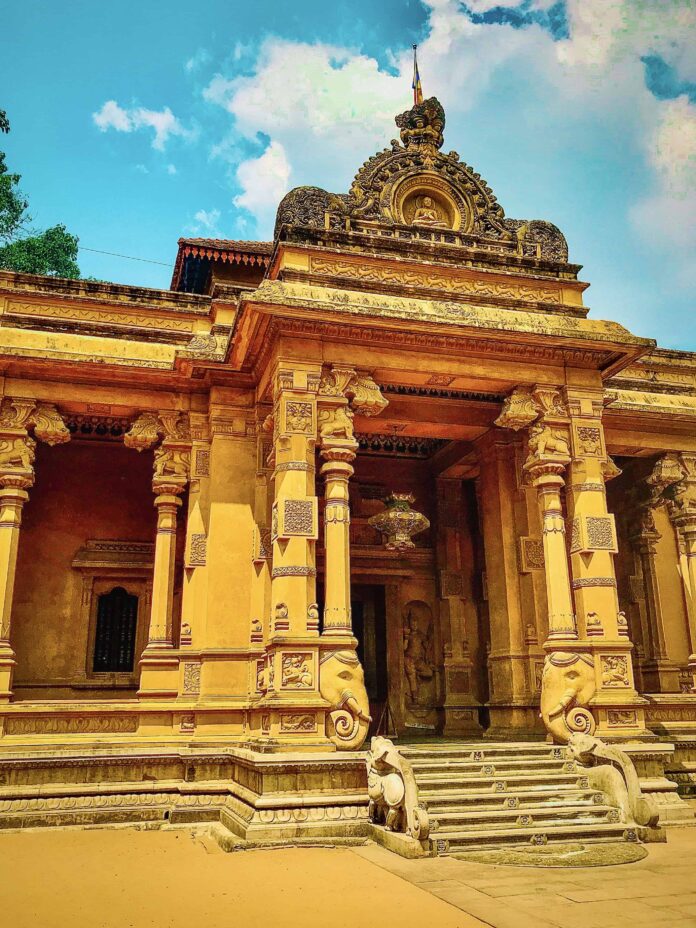Kelaniya Raja Maha Vihara
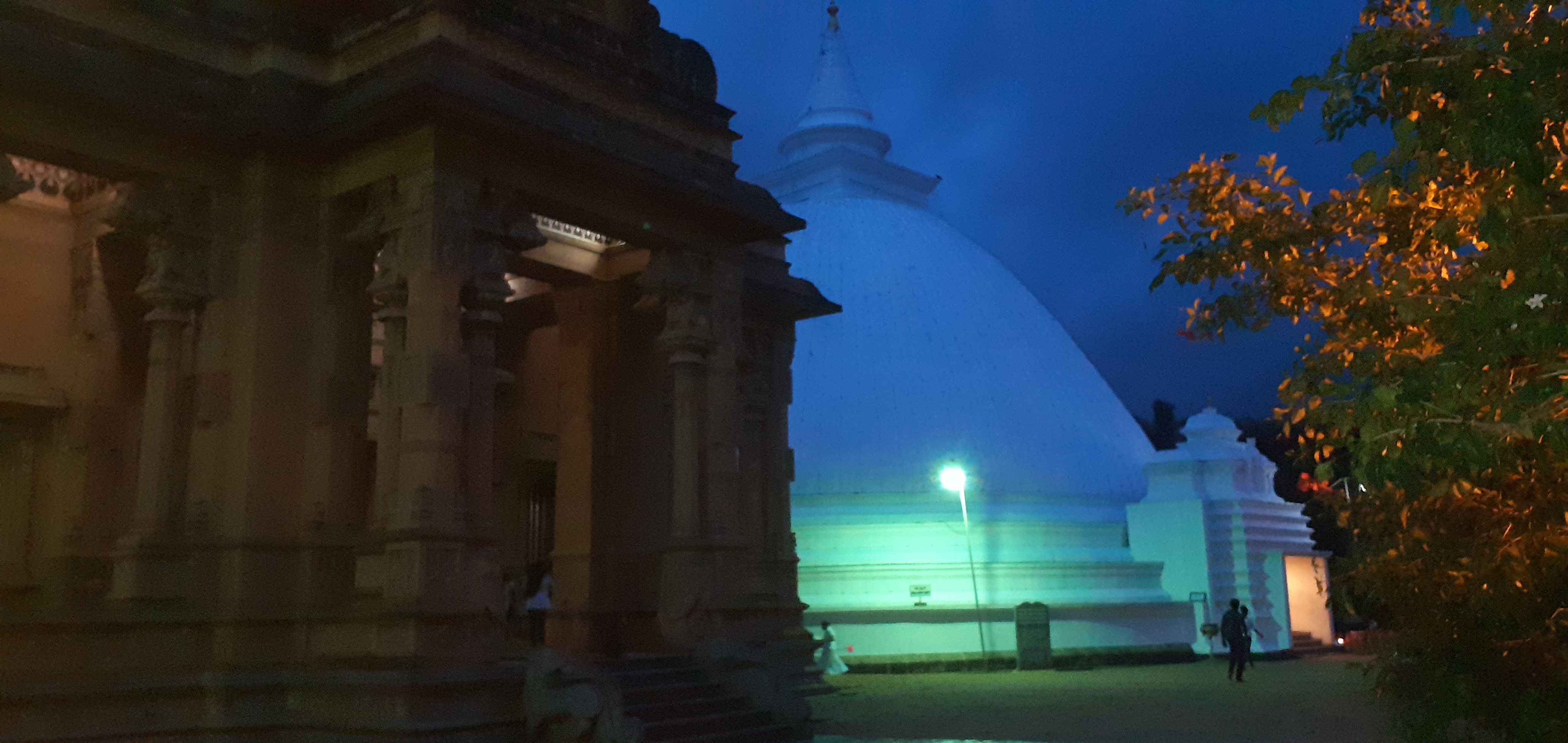
Kelaniya Raja Maha Vihara is the most sacred and the most beautiful temple situated in the Gampaha District of the Western Province of Sri Lanka. The temple is about 10 km from Colombo and can be reached by following the roads either at Thorana Junction (Waragoda Road) or at 4th Mile Post Junction (Biyagama Road) in Colombo – Kandy A1 Road. The temple stands on the west bank of the River Kelani.
Out of the three gates that provide entrance to the temple, the main gate that directly opens into the Kelaniya bus stand is the widely used one. This gate provides a way to the lower terrace of the temple through a neatly arranged yard which consists of beautiful trees, ponds and fountains whilst giving the best view of the temple to the visitors. The twin stairways that provide access to the upper terrace of the Temple end up with blissful Thorana structures that improve the splendour of this ancient temple while pleasing the visitors with a sense of a grand welcome.
Although the temple has been occupied with pilgrims and tourists all the time, the glory and serenity in the sanctum never depart. No entrance fees are charged at this place even from the foreigners and wearing a charming, light-coloured costume that covers the legs and sleeves as applicable to any Buddhist temple in Sri Lanka will make you eligible to enter the temple.
Kelaniya Temple History
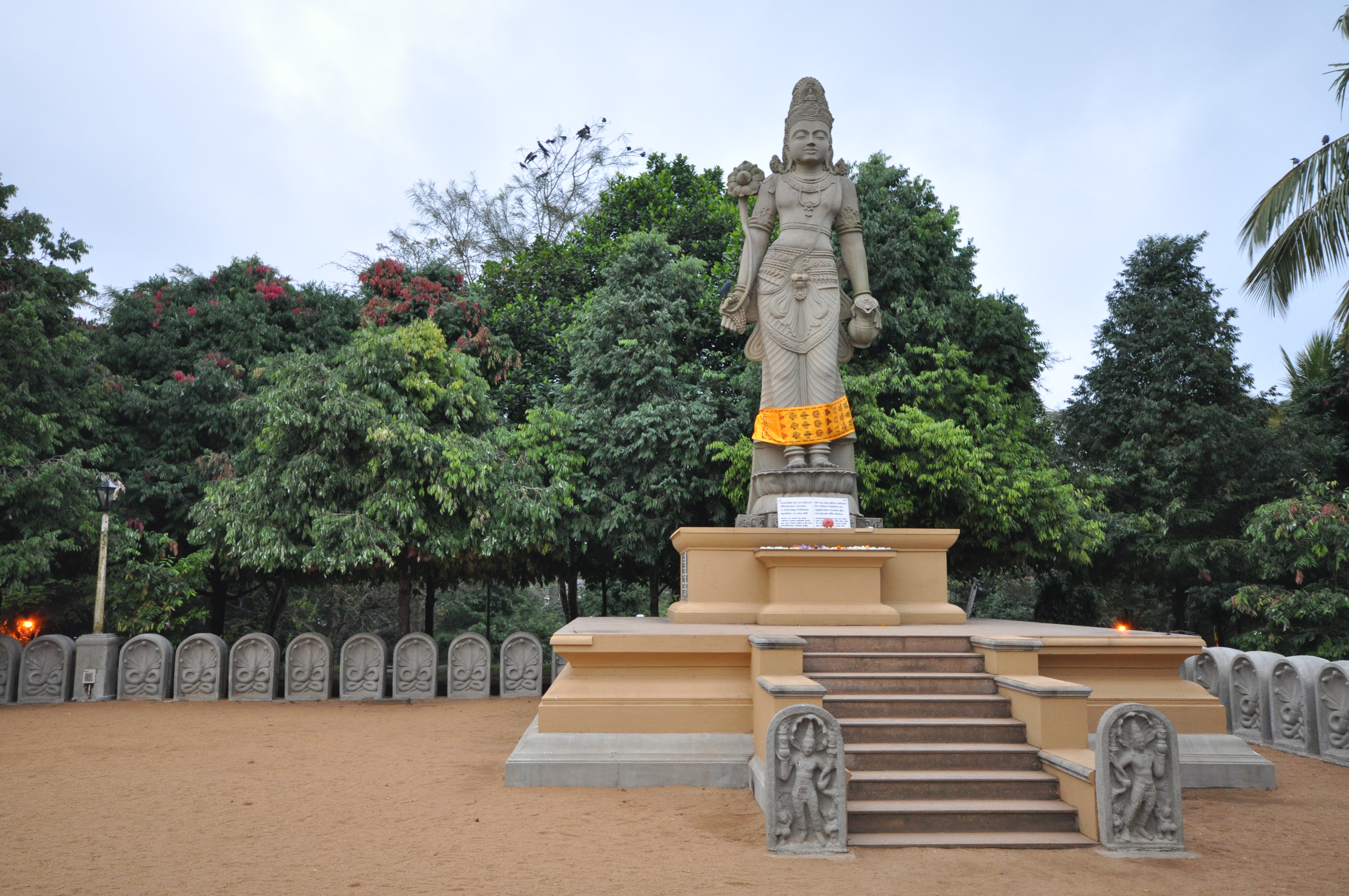
Kelaniya Raja Maha Vihara is considered as one of the oldest temples and its history goes back to the time before chronologically recorded narration of Sri Lanka. Kelaniya became a sacred place of Buddhists after it was visited by the Gauthama Buddha. This was the third and final visit of Gauthama Buddha to Sri Lanka and it happened eight years after gaining enlightenment. The chronicles, Dipavansa and Mahavansa, record in detail the story of the Buddha’s visit on a full moon poya day to Kelaniya on the invitation of Naga King Maniakkhika. The Buddha has arrived Kelaniya with 500 arhats Theros on this day. After visiting Kelaniya, the Buddha has visited Katharagama and Sumana Kuta (the mountain of God Sumana Saman or Sri Pada or Adam’s Peak) during the same visit.
The initial temple is said to be built by King Yatalatissa in 543 B.C., on the ground where the Buddha preached dhamma to people in Kelaniya, enshrining the jewelled seat on which the Buddha sat for the preaching. The temple, however, received its sacred status and became a place of Buddhist worship after Arhath Mahinda brought dhamma to the island in 307 B.C.
After the arrival of Arahant Mahinda, this temple was renovated by Prince Uththiya, the brother of King Devanampiyatissa.
This renovation included the first-ever residential quarters of the Buddhist monks called ‘Sanghawasa’.
The Kelaniya Raja Maha Vihara is important in every historical and historical period. In 1424 and 1475, Buddhist monks from Cambodia, Thailand, and Burma visited the colony. Since then it has been an important religious centre for centuries and has undergone a series of developments.
This temple has been frequently destroyed throughout history by the Tamil invaders in South India. In 1510 it was completely destroyed by the Portuguese. Reconstruction of the temple was carried out, in the patronage of King Kirthi Sri Rajasingha (1746-1778) during times that the Dutch held sway in the western coastal belt of the country. Following the betrayal of the ancient island nation to the British Colonialists by the highland nobles in the Kandyan Kingdom in 1815, the social fabric of Sri Lanka was ruined and the temples including Kelaniya Raja Maha Vihara underwent vandalism along with declined numerous traditions of the country.

The temple we see today is the outcome of the last major renovation done in the 20th century (1927 – 1946) with the help of Mrs Helena Wijewardana. The renovated temple complex consists of a stupa, bodhi, old shrine, a new wing to the old shrine, new shrine, museum, monk’s residence, visitor’s rest house, dhamma shala, devala and a number of statues. After the successful renovations and new additions, Kelaniya Raja Maha Vihara has become one of the most visited temples of Sri Lankan Buddhists.
Kelaniya Stupa

According to the Mahani chronicle, the original stupa of the Kelaniya Raja Maha Vihara had a throne full of gems on which the Buddha sat and preached. The only original building of the temple that remains in the present is the stupa. The stupa, which is 90 feet in height, is also a result of many renovations; however, it still stands on the original grounds.
Kelaniya Stupa is architecturally important and the form is known as dhanyakara (heap of grains) shape. This shape is similar to the shape of Jethavana and Abhayagiri stupas in Anuradhapura. Dhanyakara shape of the stupa is fairly uncommon to find as the most seen types are ‘Bubbulakara’ (bubble) and ‘Gantakara’ (bell) shapes.
The immense space around Kelaniya Stupa in the form of a sand garden (Weli Maluwa) provides an opportunity for the pilgrims to engage in religious rituals with peace in mind, despite the presence of a large number of visitors at any given time.
Kelaniya Bodhi

Kelaniya Bodhi is considered as one of the most sacred bodhi trees of the country due to its genetic relationship with the Jaya Sri Maha Bodhi in Anuradhapura. The mother tree of Kelaniya Bodhi is a one out of eight bodhi trees emerged out of fruits of Jaya Sri Maha Bodhi (Ashta Pala Ruha). Kelaniya Bodhi has been frequently treated by the pilgrims in the form of ‘Bodhi Pooja’, in the faith of the healing power of this ancient tree.
Kelaniya Shrine

Kelaniya Shrine consists of an old shrine, a new wing to the old shrine, the new shrine, an array of recumbent carved statues of Buddha, a series of status of deities, Makara Thorana (Dragon Arches) and Sinha Makara Thorana (Lion Dragon Arches). This shrine itself is a testament to the Buddhist culture of Sri Lanka in a low country. The representation of the god Hanuman among the gods is an unusual feature. Apparently based on the connection of the Kelaniya epic with the Ramayana.
The paintings in the ancient shrines date back to the middle of the nineteenth century. According to the inscription on the ornaments on the front of the temple, it is dated to c. 1851 gives the date. The style of the paintings also confirms this date. Renovations in the early twentieth century added new wings to the old shrine and built a new shrine of great beauty The church we see today is enriched with all the elements of an ancient Sri Lankan Buddhist shrine, including Sandaka Pahana, Muragala and Bhairava Rupa.
Kelaniya Frescoes
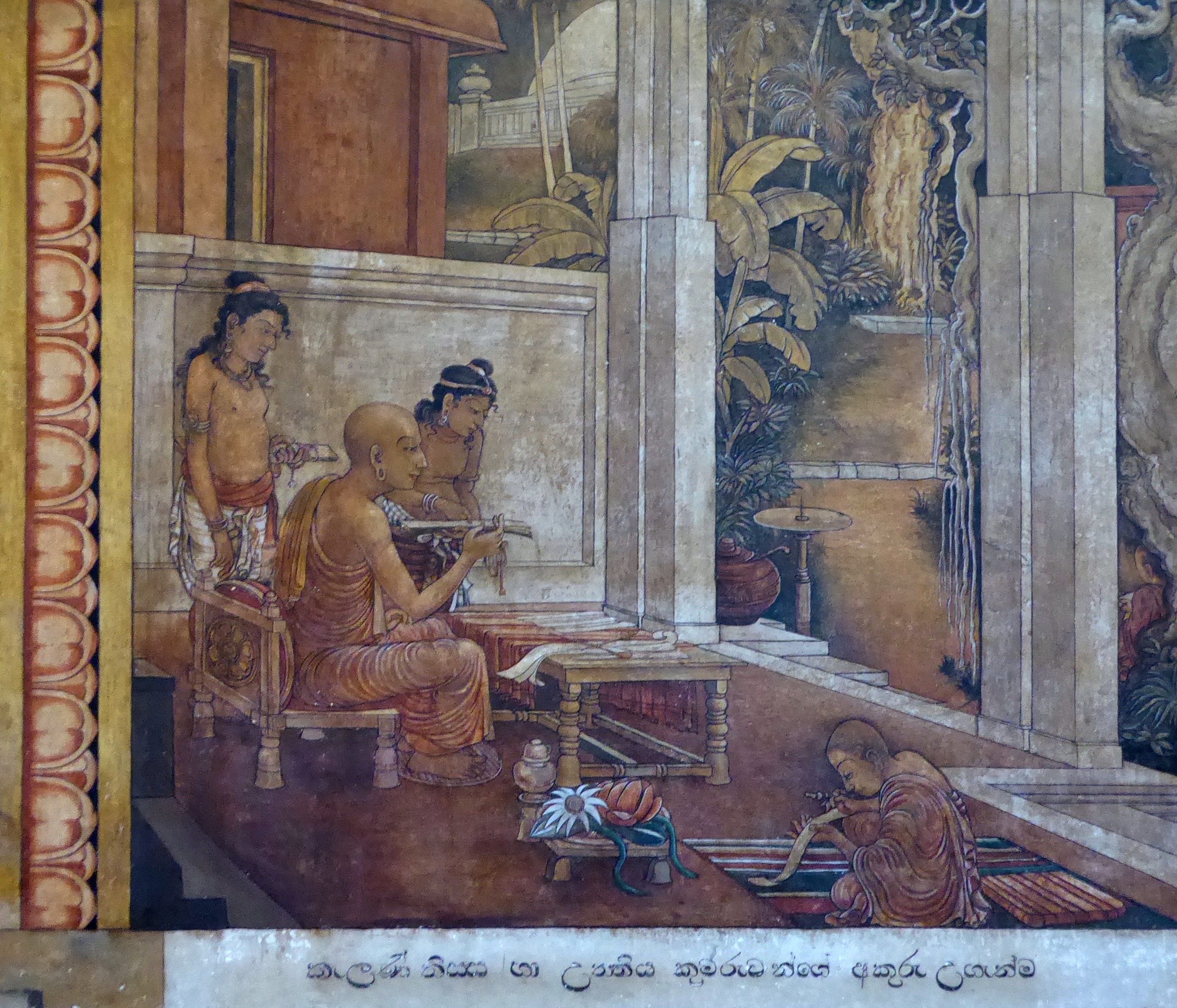
Kelaniya Frescoes are justifiably considered as the best work of Sri Lankan frescoes after the Polonnaruwa period. Murals consisting of regular rectangular panels are pleasing to the eye in their understated colours. Line works are robust and retain rhythm all the time. Depiction of character by a certainty of modelling has been achieved to a magnificent degree as done the same by the artist of ancient Sigiriya Frescoes.
The Kelaniya murals depict important events in the life of the Buddha, the history of Buddhism in Sri Lanka, and the events of the Jataka (Buddha’s previous life) stories. The entry of Sinhalese Buddhist history into the panels of Kelaniya Frescoes is especially significant following the paintings of Golden Dambulla Rock Cave Temple where the duel between King Dutugemunu (161-137 B.C.), the Hero of Sri Lanka and Elara, the Dravidian invader from southern India had been painted.
The older paintings of Kelaniya belong to the low country idiom of the Sittara art tradition of the nineteenth century. The selection of the themes also conforms to the general pattern found at the shrines of the same period. The arrangement of the paintings in the sanctum, with its emphasis on the presence of important divinities attending on the Buddha, however, is found only a few other shrines, of the island. The exaltation of the Naga King Maniakkhika, the special emphasis given to the Buddha’s visit, represents the unique features of Kelaniya Frescoes, inspired by the history of the city.
The ceiling of the entrance of the old shrine has been devoted to the themes dealing with cosmology. It consists of seven panels and is scrolled through garland and palace designs. Four of these represent the tree of life, each of which differs from the tree and the surrounding environment, but each symbolizes the axis of the universe from which all kinds of life originated. The other three panels contain three systematic universal diagrams. Twelve signs of the zodiac that mark the twelve phases of the Sun’s annual cyclic motion are shown on one board. Another contains the nine divine guardians of the world directions, conceived of as identical with the nine planets that rule man’s life. The ten incarnations of Vishnu which are associated with the cyclic evolution of the world, namely, its creation, destruction and re-creation are found in the other panel.

The ceiling space was obviously designed of as the vault of heaven in which the sun, the moon, the constellations and the planets rotate. Nevertheless, there could have been another consideration behind the installation of such diagrams in religious edifices. According to ancient practice, such an act would have transformed the structures into the axis of the Universe, the place of origin, and the consecrated abode for the Supreme Lord of the Faith. And, vice versa, by the very act of incorporating cosmological diagrams in the Buddha shrines, it has been emphasized that the entire cosmos and all the divine powers that rule the world and the destiny of mankind would come under the auspicious influences and the benevolent protection of the Buddha.
The new shrine, together with an additional wing to the old shrine of Kelaniya Raja Maha Vihara has been painted entirely with a completely new style of the old idiom. This was done by one of the greatest painters of the era, illustrious Solius Mendis, the highly respected master painter of the neo-classical tradition of Sri Lanka. He brought the ancient paintings to its original glory by using paints that were made from organic materials. The renovation work took almost 20 years to complete and the patience that the artist has shown towards eminence in final outcome is obvious in each and every painting.
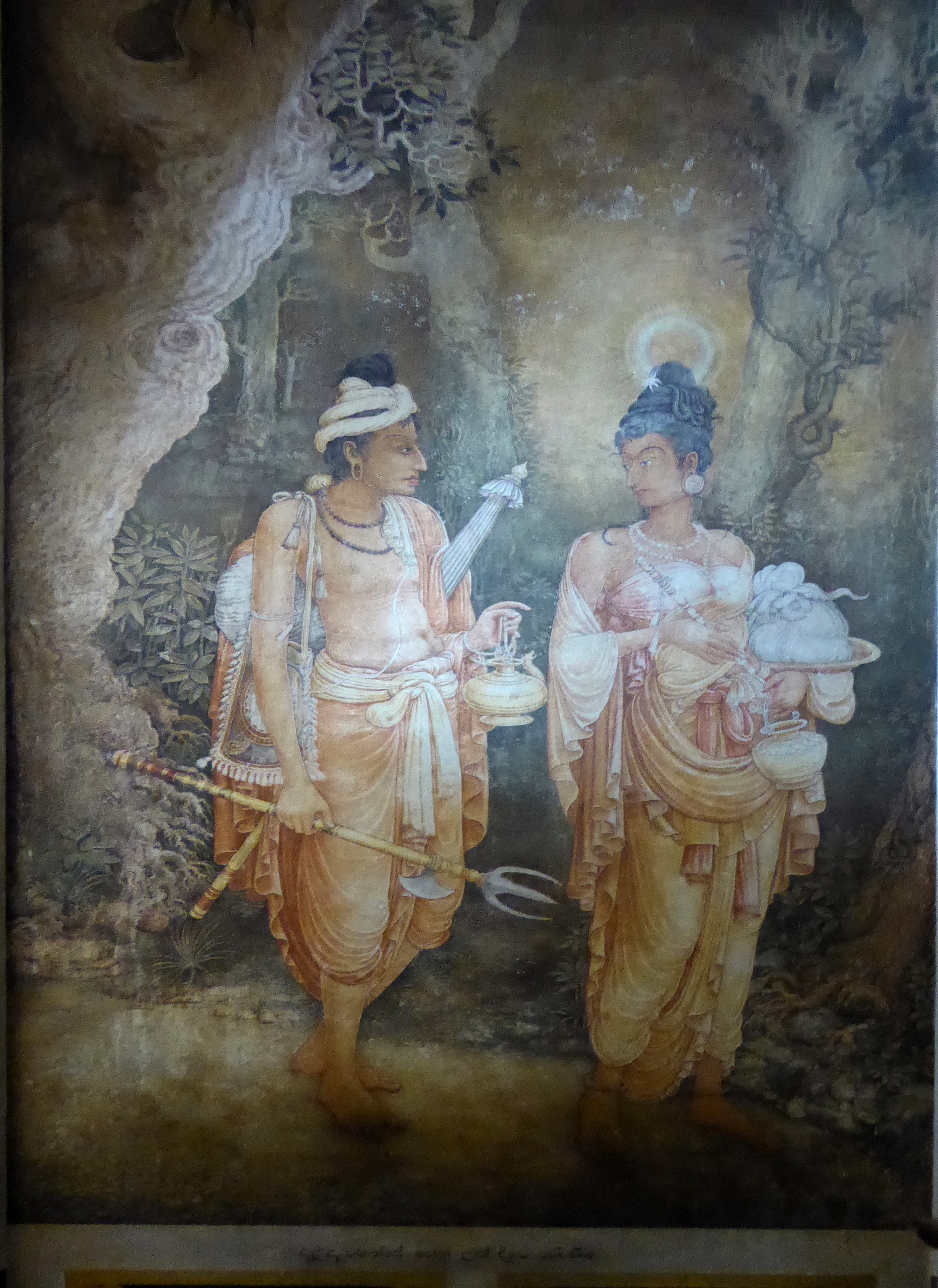
As all have been the creations of a single artist, the modern paintings of the Kelaniya Raja Maha Vihara are not comparable. However, the inspiration gained by the artist through his studies of ancient Indian and Sri Lankan painting is quite apparent.
The graceful faces of Prince Dantha and Princess Hemamala with elegantly arranged coiffures in the panel on the arrival of Sacred Tooth Relic of Buddha draw its inspiration from the Sigiriya Frescoes. The flying divinities in the panel on Sumana Kuta remind the flying celestials of famous Ajanta Frescoes at Ajanta Caves in India. The portrayal of the Buddha and the divinities seems to have been influenced by the paintings at the Tivanka Pilimage at Polonnaruwa. The royal personages worshipping the Gauthama Buddha, with their outstretched hands in various postures, are suggesting the artist’s study of second-century Andhra sculptures. The two magnificent panels depicting the arrival of Buddhist nun Theri Sangamitta, bringing a sapling of the sacred Jaya Sri Maha Bodhi tree from India to Sri Lanka have been painted by the brush of the Bengali revivalists of classical Indian culture.
Kelaniya Statues
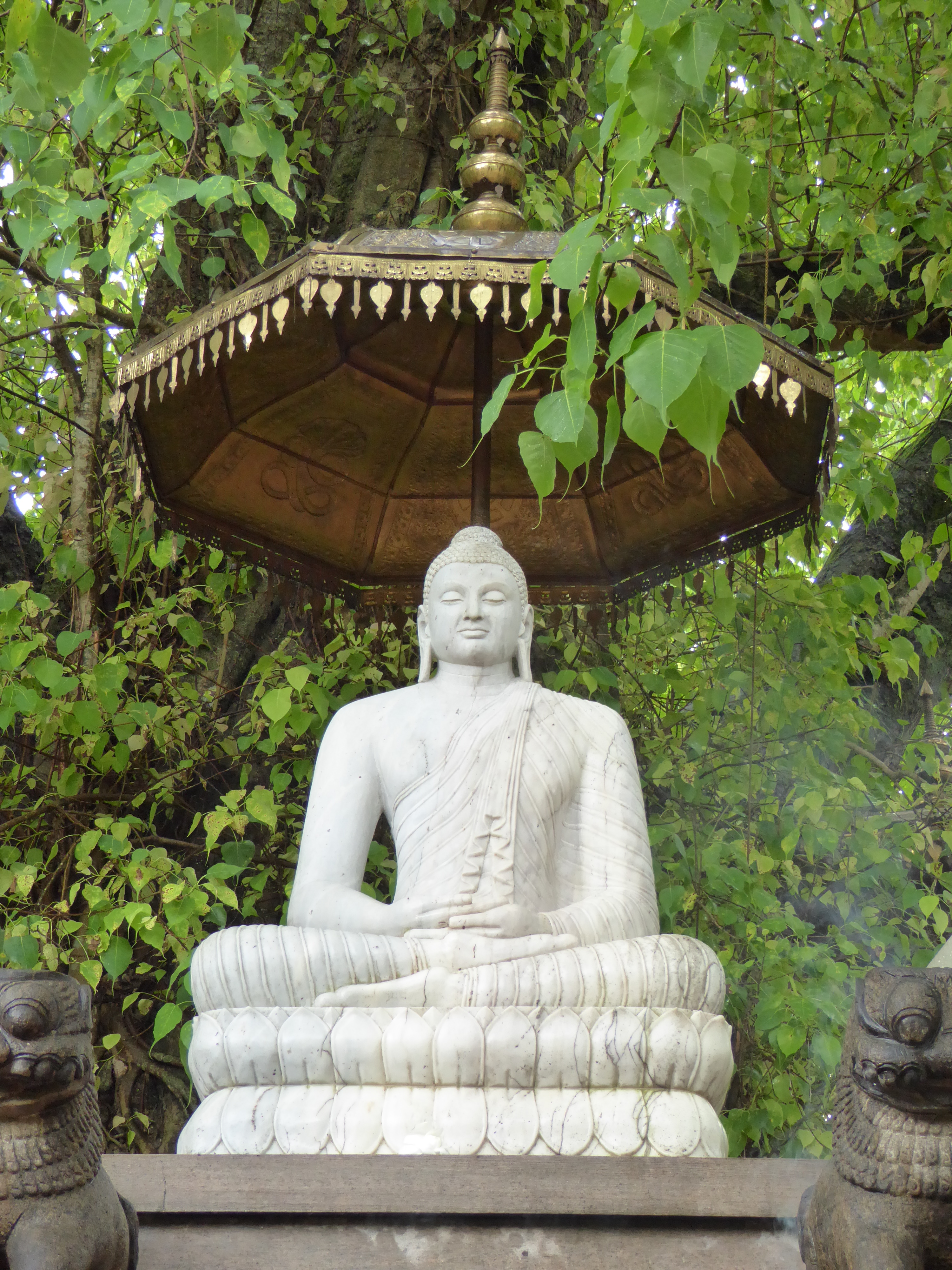
Kelaniya Raja Maha Vihara is famous for its statues of seated and reclining Gautama Buddha in the shrine. There is also a series of statues of deities in the shrine. There are four seated Buddha statues around the Bodhi tree. Located at the left side of the main entrance, the statue expressing the most difficult six years of life (Dushkara Kriya) is an uncommon one, which describes the non-comparable devotion of Bodhisattva Siduhath towards enlightenment.
At a corner of the upper terrace of the temple, an 18 feet stone statue of the Bodhisattva Avalokitesvara has been erected. Another corner of the same terrace has been occupied by the statue of Bodhisattva Maithree (believed as the next Buddha). There is also a statue of Vihara Maha Devi, the daughter of King Kelanitissa, wife of King Kawantissa and the mother of King Dutugemunu, who has been considered as one of the greatest women in the Sri Lankan history.
Kelaniya Sivuru Gala
This place is considered to be the place where the Buddha kept the robe (sivura) while bathing in the Kelani River. This is a covered granite stone situated at the right side of the main entrance of the temple and most of the visitors may not notice the place unless they walk calmly all along while enjoying the cool breeze under an array of a tree that surrounds the upper garden of the temple.
Kelaniya Vibhishana Devala
There is a direct link between Ramayana and Kelaniya Raja Maha Vihara. Ramayana states that after the death of King Ravana, King Vibhishana was crowned to rule the Kelaniya area and Vibhishana’s palace was on the banks of the River Kelani.
King Vibhishana was considered a fair king, as he supported Rama against his own brother’s injustice. He is still considered as one of the 4 guardian deities (Sathara Waram Deviyo) and there are many temples for the God Vibhishana (Vibhishana Deviyo) throughout Sri Lanka. Out of those, the Vibhishana Devala at Kelaniya Raja Maha Vihara is of utmost importance due to its historical significance. Many devotees that visit this place pray for the interventions of God Vibhishana with the hope of a fair recourse to their problems even today.
Kelaniya Duruthu Maha Perahara
In celebration of the event of Buddha’s visit, Kelaniya Raja Maha Vihara conducts a procession annually, called Duruthu Maha Perahara. Begun in 1927 by Mrs Helena Wijewardena’s son Mr Don Walter Wijewardena, this is one of the main highlights in the temple’s calendar. It is held on the full moon poya day in each January and regarded as a major religious pageant of the country.
On the first day, the procession is confined to circling around the upper terrace of the temple, called the Uda Maluwe Perahera. Elephants, drummers and dancers are there but are few in number. The sacred casket of relics is placed on a cushion and is carried around the temple thrice by the Chief Basnayake Nilame. On the second night, the tenor, tempo and colour increase as more elephants, drummers and dancers join the parade. On this night, the procession makes its way around the lower temple square, called the Pahala Maluwe Perahera.
On the night of the Duruthu Poya is the grand procession, which consists of large numbers of whip crackers, fireball artists, drummers, dancers and richly dressed elephants. The processions of the three Devalas Kataragama, Vishnu and Vibishana, join the perahera. Thousands of locals and foreigners gather to watch this splendid pageant and the dignity of the event is second only to the Kandy Esala Perahara.
Q: What makes Kelaniya Raja Maha Vihara so special?
A: Kelaniya’s charm lies in its harmonious blend of architectural marvels, sacred relics, and captivating legends. The iconic whitewashed stupa, adorned with intricate carvings, houses the Buddha’s inner robe, imbued with immense spiritual significance.
Q: How do I reach the temple?
A: Kelaniya’s convenient location, just 10 kilometers northeast of Colombo, makes it easily accessible. You can:
Ride the 150 bus directly from Colombo.
Hop on a train to Kelaniya station and take a tuk-tuk from there.
Opt for a taxi or private car for a comfortable journey.
Q: What are the opening and closing hours?
A: The temple welcomes visitors from dawn to dusk, typically from 5:00 AM to 7:00 PM. However, specific areas like the inner sanctum might have slightly different timings.
Q: What is the appropriate attire for visiting the temple?
A: As a revered spiritual site, dressing modestly is essential. Opt for long pants or skirts and shirts that cover your shoulders. Avoid revealing or brightly colored clothing.
Q: Are there any special festivals or events I should be aware of?
A: Kelaniya comes alive during numerous Buddhist festivals throughout the year. The grand Esala Perahera, held in July, is a vibrant spectacle with adorned elephants and traditional dancers. Check the temple’s calendar for upcoming events to witness these cultural gems.
Q: Can I take photos inside the temple?
A: Photography is generally permitted within the temple complex, except for specific areas like the inner sanctum.
Q: Are there any offerings I can make?
A: Devotees often make offerings of flowers, incense, or food. You can purchase these from vendors outside the temple premises. Remember to offer them with a respectful and prayerful mind.
Q: Are there any guidelines for behavior within the temple?
A: Maintaining a peaceful and respectful demeanor is paramount. Speak softly, avoid using mobile phones excessively, and be mindful of your actions to preserve the sacred atmosphere.
Q: What are some interesting facts about Kelaniya Raja Maha Vihara?
A: Kelaniya boasts a treasure trove of fascinating stories. Legend has it that the Buddha himself visited the site and gifted his robe to King Kelani. The temple also played a significant role in Sri Lanka’s ancient history, serving as a royal monastery and a center of learning.
Q: Are there any places to stay or eat near the temple?
A: Several budget-friendly guesthouses and restaurants are located within walking distance of the temple. You can also find upscale hotels and eateries in Colombo, a short commute away.
